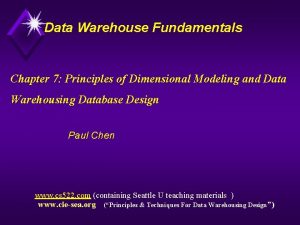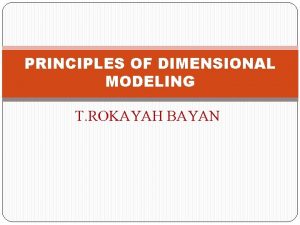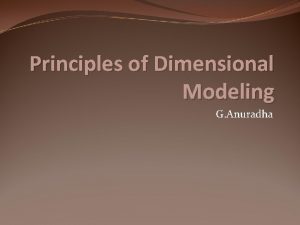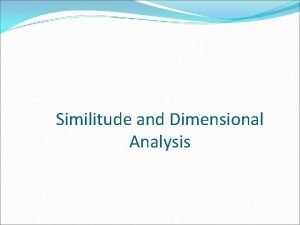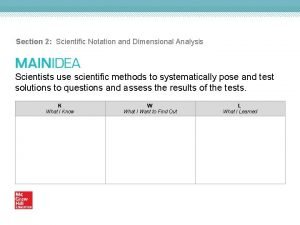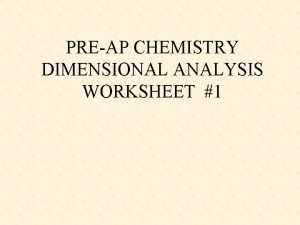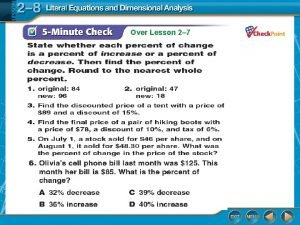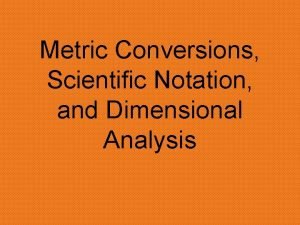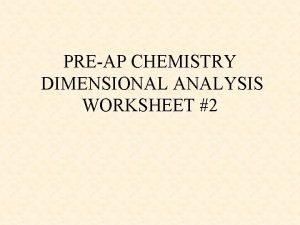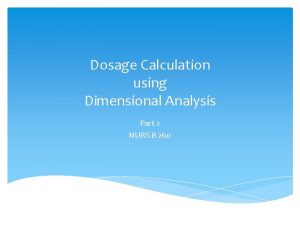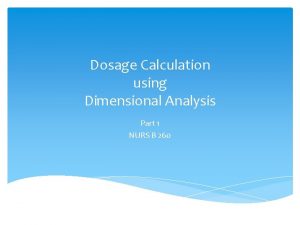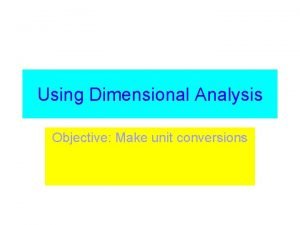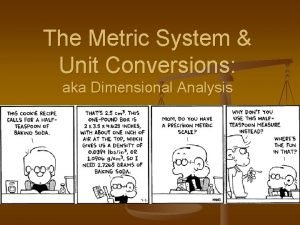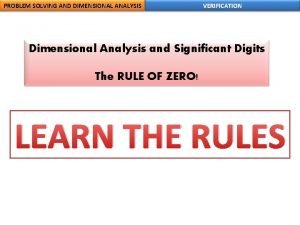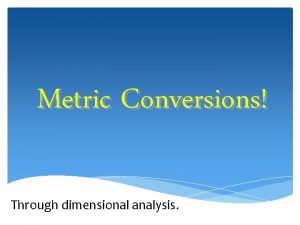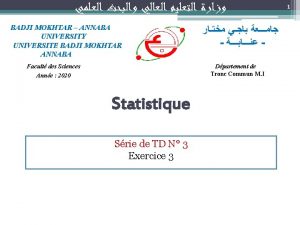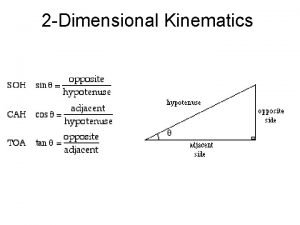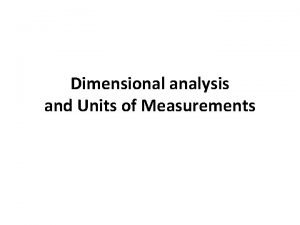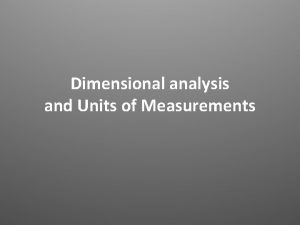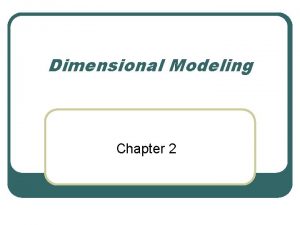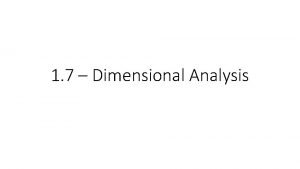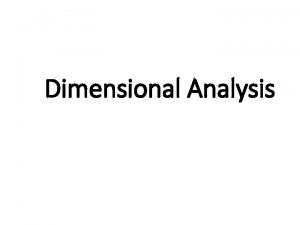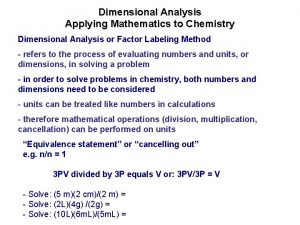Chapter 7 DIMENSIONAL ANALYSIS AND MODELING ZULFAKAR MOKHTAR





































- Slides: 37

Chapter 7 DIMENSIONAL ANALYSIS AND MODELING ZULFAKAR MOKHTAR

Objectives • Develop a better understanding of dimensions, units, and dimensional homogeneity of equations • Understand the numerous benefits of dimensional analysis • Know how to use the method of repeating variables to identify nondimensional parameters • Understand the concept of dynamic similarity and how to apply it to experimental modeling 2

7– 1 ■ DIMENSIONS AND UNITS Dimension: A measure of a physical quantity (without numerical values). Unit: A way to assign a number to that dimension. There are seven primary dimensions (also called fundamental or basic dimensions): mass, length, time, temperature, electric current, amount of light, and amount of matter. All nonprimary dimensions can be formed by some combination of the seven primary dimensions. A dimension is a measure of a physical quantity without numerical values, while a unit is a way to assign a number to the dimension. For example, length is a dimension, but centimeter is a unit. 3

4

The water strider is an insect that can walk on water due to surface tension. 5

7– 2 ■ DIMENSIONAL HOMOGENEITY The law of dimensional homogeneity: Every additive term in an equation must have the same dimensions. Total energy of a system at state 1 and at state 2. You can’t add apples and oranges! 6

An equation that is not dimensionally homogeneous is a sure sign of an error. 7

The Bernoulli equation is a good example of a dimensionally homogeneous equation. All additive terms, including the constant, have the same dimensions, namely that of pressure. In terms of primary dimensions, each term has dimensions {m/(t 2 L)}. 8

9

Nondimensionalization of Equations Nondimensional equation: If we divide each term in the equation by a collection of variables and constants whose product has those same dimensions, the equation is rendered nondimensional. Normalized equatiion: If the nondimensional terms in the equation are of order unity, the equation is called normalized. Each term in a nondimensional equation is dimensionless. Nondimensional parameters: In the process of nondimensionalizing an equation of motion, nondimensional parameters often appear—most of which are named after a notable scientist or engineer (e. g. , the Reynolds number and the Froude number). This process is referred to by some authors as inspectional analysis. A nondimensionalized form of the Bernoulli equation is formed by dividing each additive term by a pressure (here we use P ). Each resulting term is dimensionless (dimensions of {1}). 10

Dimensional variables: Dimensional quantities that change or vary in the problem. Examples: z (dimension of length) and t (dimension of time). Nondimensional (or dimensionless) variables: Quantities that change or vary in the problem, but have no dimensions. Example: Angle of rotation, measured in degrees or radians, dimensionless units. Dimensional constant: Gravitational constant g, while dimensional, remains constant. Parameters: Refer to the combined set of dimensional variables, nondimensional variables, and dimensional constants in the problem. Pure constants: The constant 1/2 and the exponent 2 in equation. Other common examples of pure constants are and e. Object falling in a vacuum. Vertical velocity is drawn positively, so w < 0 for a falling object. 11

To nondimensionalize an equation, we need to select scaling parameters, based on the primary dimensions contained in the original equation. Froude number In a typical fluid flow problem, the scaling parameters usually include a characteristic length L, a characteristic velocity V, and a reference pressure difference P 0 P. Other parameters and fluid properties such as density, viscosity, and gravitational acceleration enter the problem as well. 12

The two key advantages of nondimensionalization of an equation. 13

Throwing a baseball on the moon 14

15

7– 3 ■ DIMENSIONAL ANALYSIS AND SIMILARITY In most experiments, to save time and money, tests are performed on a geometrically scaled model, rather than on the full-scale prototype. In such cases, care must be taken to properly scale the results. We introduce here a powerful technique called dimensional analysis. The three primary purposes of dimensional analysis are • To generate nondimensional parameters that help in the design of experiments (physical and/or numerical) and in the reporting of experimental results • To obtain scaling laws so that prototype performance can be predicted from model performance • To (sometimes) predict trends in the relationship between parameters The principle of similarity Three necessary conditions for complete similarity between a model and a prototype. (1) Geometric similarity—the model must be the same shape as the prototype, but may be scaled by some constant scale factor. (2) Kinematic similarity—the velocity at any point in the model flow must be proportional (by a constant scale factor) to the velocity at the corresponding point in the prototype flow. 16

(3) dynamic similarity—When all forces in the model flow scale by a constant factor to corresponding forces in the prototype flow (force-scale equivalence). Kinematic similarity is achieved when, at all locations, the speed in the model flow is proportional to that at corresponding locations in the prototype flow, and points in the same direction. In a general flow field, complete similarity between a model and prototype is achieved only when there is geometric, kinematic, and dynamic similarity. 17

We let uppercase Greek letter Pi ( ) denote a nondimensional parameter. In a general dimensional analysis problem, there is one that we call the dependent , giving it the notation 1. The parameter 1 is in general a function of several other ’s, which we call independent ’s. To ensure complete similarity, the model and prototype must be geometrically similar, and all independent groups must match between model and prototype. To achieve similarity 18

Geometric similarity between a prototype car of length Lp and a model car of length Lm. The Reynolds number Re is formed by the ratio of density, characteristic speed, and characteristic length to viscosity. Alternatively, it is the ratio of characteristic speed and length to kinematic viscosity, defined as = /. The Reynolds number is the most well known and useful 19 dimensionless parameter in all of fluid mechanics.

A drag balance is a device used in a wind tunnel to measure the aerodynamic drag of a body. When testing automobile models, a moving belt is often added to the floor of the wind tunnel to simulate the moving ground (from the car’s frame of reference). 20

21

A drag balance is a device used in a wind tunnel to measure the aerodynamic drag of a body. When testing automobile models, a moving belt is often added to the floor of the wind tunnel to simulate the moving ground (from the car’s frame of reference). 22

23

24

If a water tunnel is used instead of a wind tunnel to test their one-fifth scale model, the water tunnel speed required to achieve similarity is One advantage of a water tunnel is that the required water tunnel speed is much lower than that required for a wind tunnel using the same size model (354 km/h for air and 25. 7 km/h for water). Similarity can be achieved even when the model fluid is different than the prototype fluid. Here a submarine model is tested in a wind tunnel. 25

7– 4 ■ THE METHOD OF REPEATING VARIABLES AND THE BUCKINGHAM PI THEOREM How to generate the nondimensional parameters, i. e. , the ’s? There are several methods that have been developed for this purpose, but the most popular (and simplest) method is the method of repeating variables. A concise summary of the six steps that comprise the method of repeating variables. 26

27

Step 1 Step 2 Step 3 Step 4 Setup for dimensional analysis of a ball falling in a vacuum. Elevation z is a function of time t, initial vertical speed w 0, initial elevation z 0, and gravitational constant g. 28

Guidelines for choosing repeating parameters (Table 7 -3 (page 306) • Never pick the dependent variable - z • Must not by themselves be able to form a dimensionless group – t, w 0, z 0 can form (tw 0/z 0) • Must represent all the primary dimensionschoose 2 repeating parameters from 3 primary dimensions (m, L, t). You can’t choose length and time. Appropriate choice would be density and time 29

Guidelines for choosing repeating parameters (continued. . ) • Never pick parameters that are already dimensionless – θ (radian and degree are dimensionless units) • Never pick two parameters with the same dimensions – z and z 0 • Choose dimensional constants over dimensional variables - t is dimensional variable • Pick common parameters – in fluid flow we generally pick length, velocity, mass or density – w 0 and z 0 are wiser choices than g 30

Step 5 31

The mathematical rules for adding and subtracting exponents during multiplication and division, respectively. It is wise to choose common parameters as repeating parameters since they may appear in each of your dimensionless groups. The groups that result from the method of repeating variables are guaranteed to be dimensionless because we force the overall exponent of all seven primary dimensions to be zero. 32

Step 6 The method of repeating variables cannot predict the exact mathematical form of the equation. A quick check of your algebra is always wise. 33

The pressure inside a soap bubble is greater than that surrounding the soap bubble due to surface tension in the soap film. 34

If the method of repeating variables indicates zero ’s, we have either made an error, or we need to reduce j by one and start over. 35

36

37
 Dr zulfakar
Dr zulfakar Relational vs dimensional data modeling
Relational vs dimensional data modeling Modeling and role modeling theory
Modeling and role modeling theory Sherif eldeeb
Sherif eldeeb Sherief kamel
Sherief kamel Mokhtar hamdi
Mokhtar hamdi Reem mokhtar
Reem mokhtar Sherif khattab md
Sherif khattab md Circular motion is one dimensional or two dimensional
Circular motion is one dimensional or two dimensional Principles of dimensional modeling
Principles of dimensional modeling Dimensional modeling basics
Dimensional modeling basics Factless fact table
Factless fact table Dimensional modeling basics
Dimensional modeling basics Definition of similitude
Definition of similitude Dimensional analysis and its applications
Dimensional analysis and its applications Scientific notation and dimensional analysis
Scientific notation and dimensional analysis Ap chemistry dimensional analysis worksheet
Ap chemistry dimensional analysis worksheet 2-7 literal equations and dimensional analysis
2-7 literal equations and dimensional analysis Metric conversions scientific notation
Metric conversions scientific notation Simulation modeling and analysis law kelton
Simulation modeling and analysis law kelton Dfd fragment
Dfd fragment Requirements modeling in system analysis and design
Requirements modeling in system analysis and design Competency modeling vs job analysis
Competency modeling vs job analysis Manufacturing systems modeling and analysis
Manufacturing systems modeling and analysis Strategic staffing definition
Strategic staffing definition Dimensional analysis worksheet 2
Dimensional analysis worksheet 2 How to calculate ml/hr
How to calculate ml/hr Nursing dimensional analysis practice
Nursing dimensional analysis practice Whats a conversion factor
Whats a conversion factor Dimensional analysis chemistry definition
Dimensional analysis chemistry definition Dollar bill
Dollar bill Dimensional analysis lesson
Dimensional analysis lesson Dimensional analysis grams to moles
Dimensional analysis grams to moles What are two dimensional analysis of objectives
What are two dimensional analysis of objectives Metric system in america
Metric system in america Dimensional analysis definition math
Dimensional analysis definition math Dimensional analysis metric conversions
Dimensional analysis metric conversions Dimensional analysis activity
Dimensional analysis activity









